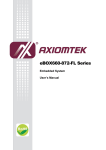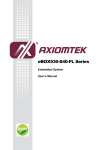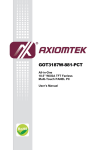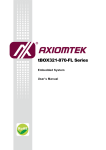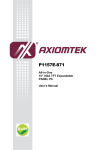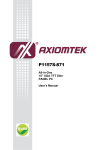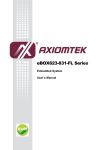Download eBOX620-801 A2 User Manual
Transcript
eBOX670-883-FL Series Embedded System User’s Manual Disclaimers This manual has been carefully checked and believed to contain accurate information. Axiomtek Co., Ltd. assumes no responsibility for any infringements of patents or any third party’s rights, and any liability arising from such use. Axiomtek does not warrant or assume any legal liability or responsibility for the accuracy, completeness or usefulness of any information in this document. Axiomtek does not make any commitment to update the information in this manual. Axiomtek reserves the right to change or revise this document and/or product at any time without notice. No part of this document may be reproduced, stored in a retrieval system, or transmitted, in any form or by any means, electronic, mechanical, photocopying, recording, or otherwise, without the prior written permission of Axiomtek Co., Ltd. Copyright 2014 Axiomtek Co., Ltd. All Rights Reserved Aug 2014, Version A1 Printed in Taiwan ii Safety Precautions Before getting started, please read the following important safety precautions. 1. The eBOX670-883-FL does not come equipped with an operating system. An operating system must be loaded first before installing any software into the computer. 2. Be sure to ground yourself to prevent static charge when installing the internal components. Use a grounding wrist strap and place all electronic components in any static-shielded devices. Most electronic components are sensitive to static electrical charge. 3. Disconnect the power cord from the eBOX670-883-FL before making any installation. Be sure both the system and the external devices are turned OFF. Sudden surge of power could ruin sensitive components. Make sure the eBOX670-883-FL is properly grounded. 4. Make sure the voltage of the power source is correct before connecting the equipment to the power outlet. 5. Turn OFF the system power before cleaning. Clean the system using a cloth only. Do not spray any liquid cleaner directly onto the screen. 6. Do not leave this equipment in an uncontrolled environment where the storage temperature is below -45℃ or above 80℃. It may damage the equipment. 7. Do not open the system’s back cover. If opening the cover for maintenance is a must, only a trained technician is allowed to do so. Integrated circuits on computer boards are sensitive to static electricity. To avoid damaging chips from electrostatic discharge, observe the following precautions: Before handling a board or integrated circuit, touch an unpainted portion of the system unit chassis for a few seconds. This will help to discharge any static electricity on your body. When handling boards and components, wear a wrist-grounding strap, available from most electronic component stores. iii Classification 1. 2. 3. 4. iv Degree of production against electric shock : not classified Degree of protection against the ingress of water : IP40 Equipment not suitable for use in the presence of a flammable anesthetic mixture with air or with oxygen or nitrous oxide. Mode of operation : Continuous General Cleaning Tips You may need the following precautions before you begin to clean the computer. When you clean any single part or component for the computer, please read and understand the details below fully. When you need to clean the device, please rub it with a piece of dry cloth. 1. Be cautious of the tiny removable components when you use a vacuum cleaner to absorb the dirt on the floor. 2. Turn the system off before you start to clean up the component or computer. 3. Never drop the components inside the computer or get circuit board damp or wet. 4. Be cautious of all kinds of cleaning solvents or chemicals when you use it for the sake of cleaning. Some individuals may be allergic to the ingredients. 5. Try not to put any food, drink or cigarette around the computer. Cleaning Tools: Although many companies have created products to help improve the process of cleaning your computer and peripherals users can also use household items to clean their computers and peripherals. Below is a listing of items you may need or want to use while cleaning your computer or computer peripherals. Keep in mind that some components in your computer may only be able to be cleaned using a product designed for cleaning that component, if this is the case it will be mentioned in the cleaning. Cloth: A piece of cloth is the best tool to use when rubbing up a component. Although paper towels or tissues can be used on most hardware as well, we still recommend you to rub it with a piece of cloth. Water or rubbing alcohol: You may moisten a piece of cloth a bit with some water or rubbing alcohol and rub it on the computer. Unknown solvents may be harmful to the plastics parts. Vacuum cleaner: Absorb the dust, dirt, hair, cigarette particles, and other particles out of a computer can be one of the best methods of cleaning a computer. Over time these items can restrict the airflow in a computer and cause circuitry to corrode. Cotton swabs: Cotton swaps moistened with rubbing alcohol or water are excellent tools for wiping hard to reach areas in your keyboard, mouse, and other locations. Foam swabs: Whenever possible it is better to use lint free swabs such as foam swabs. Note: We strongly recommended that you should shut down the system before you start to clean any single components. Please follow the steps below: 1. 2. 3. 4. 5. Close all application programs Close operating software Turn off power switch Remove all device Pull out power cable v Scrap Computer Recycling If the computer equipment’s needs the maintenance or are beyond repair, we strongly recommended that you should inform your Axiomtek distributor as soon as possible for the suitable solution. For the computers that are no longer useful or no longer working well, please contact your Axiomtek distributor for recycling and we will make the proper arrangement. Trademarks Acknowledgments Axiomtek is a trademark of Axiomtek Co., Ltd. IBM, PC/AT, PS/2, VGA are trademarks of International Business Machines Corporation. ® ® Intel and Pentium are registered trademarks of Intel Corporation. MS-DOS, Microsoft C and QuickBasic are trademarks of Microsoft Corporation. Windows 8, Windows 7, Windows XPE, Windows XP, Windows WinCE embedded, Linux, MS-DOS, Microsoft C and Other brand names and trademarks are the properties and registered brands of their respective owners. vi Table of Contents Disclaimers .............................................................................................................. ii Safety Precautions ................................................................................................. iii Classification .......................................................................................................... iv General Cleaning Tips ............................................................................................ v Scrap Computer Recycling.................................................................................... vi CHAPTER 1 INTRODUCTION ................................................................................. 1 1.1 1.2 1.2.1 1.2.2 1.2.3 1.2.4 1.3 1.3.1 1.3.2 1.4 1.5 1.6 General Description ............................................................................ 1 System Specifications ........................................................................ 3 CPU .................................................................................................................... 3 I/O System ......................................................................................................... 3 System Specification ........................................................................................ 3 Driver CD Content ............................................................................................. 4 Dimensions ......................................................................................... 5 System Dimension ............................................................................................ 5 Wall mount Bracket Dimension ....................................................................... 6 I/O Outlets ........................................................................................... 7 Packing List ......................................................................................... 9 Model List ............................................................................................ 9 CHAPTER 2 HARDWARE INSTALLATION ........................................................ 11 2.1 2.2 2.3 2.4 2.5 Installing the 2.5” SATA Device ....................................................... 11 Installing the Express Mini Card ...................................................... 14 Installing the CFast Card .................................................................. 15 Installing the SIM Card ..................................................................... 16 Installing the SO-DIMM Memory ...................................................... 17 CHAPTER 3 JUMPER SETTING & CONNECTOR ............................................ 19 3.1 3.2 3.2.1 3.2.2 3.3 3.3.1 3.3.2 3.3.3 3.3.4 3.3.5 3.3.6 3.3.7 3.3.8 3.3.9 3.3.10 3.3.11 3.3.12 Jumper & Connector Location ......................................................... 19 Jumper Setting Summary ................................................................. 20 Restore BIOS Optimal Defaults (SJP2) ......................................................... 20 Mini Card Selection (SJP3) ............................................................................ 20 Connectors ........................................................................................ 21 DC-in Phoenix Power Connector .................................................................. 22 VGA Connector ............................................................................................... 22 HDMI Connector .............................................................................................. 22 DisplayPort Connector ................................................................................... 23 COM1~COM6 Serial Port Connector ............................................................. 23 USB 3.0 Connector ......................................................................................... 24 Ethernet Connector (LAN1~LAN4) ................................................................ 24 Audio Connector (SCN2, SCN1) .................................................................... 25 ATX Power On/OFF Button ............................................................................ 25 Reset Button.................................................................................................... 25 Remote Power Switch Connector (SPWRBT1) ............................................ 25 AT/ATX Switch................................................................................................. 26 vii 3.3.13 3.3.14 3.3.15 3.3.16 3.3.17 SIM Card Slots................................................................................................. 26 Serial ATA Connectors (SATA1-SATA2) ....................................................... 26 CFast™ Socket ................................................................................................ 27 Digital I/O Connector ...................................................................................... 28 Express Mini Card Slot (SCN12, SCN13) ...................................................... 29 CHAPTER 4 BIOS SETUP UTILITY ..................................................................... 31 4.1 4.2 4.3 4.4 4.5 4.6 Starting .............................................................................................. 31 Advanced Menu................................................................................. 33 Chipset Menu .................................................................................... 44 Boot Menu ......................................................................................... 48 Security Menu ................................................................................... 49 Save & Exit Menu .............................................................................. 50 APPENDIX A WATCHDOG TIMER ....................................................................... 53 About Watchdog Timer .................................................................................... 53 Sample Program ............................................................................................... 54 APPENDIX B PROGRAMMABLE LED ................................................................ 55 About Programmable LED ............................................................................... 55 Sample Code ..................................................................................................... 55 viii eBOX670-883-FL Series User’s Manual CHAPTER 1 INTRODUCTION This chapter contains general information and detailed specifications of the eBOX670-883-FL. The Chapter 1 includes the following sections: 1.1 General Description System Specifications Dimensions I/O Outlets Packing List Model List General Description th The eBOX670-883-FL is an embedded system that supports LGA1150 Socket 4 generation Intel® Core™ i7/i5/i3/Celeron processor to support W indows 7, W indows 7 Embedded, W indows 8, W indows 8 Embedded or Linux, suitable for the most endurable operation. It features fan less design with full feature I/O, two 204-pin unbuffered SODIMM socket for dual channel DDR3-1333/1600 MHz memory, and enhanced system dependability by built-in W atchdog Timer. Features ® 1. Intel Haswell Q87 Platform 2. Support LGA1150 Socket Intel® Core™ i7/i5/i3/Celeron processor 3. Maximum to 16GB SO-DIMM DDR3 1333/1600 MHz memory 4. Supports 6 USB 3.0 ports 5. Supports 6 jump-less RS-232/422/485 6. Supports 4 10/100/1000Mbps Ethernet ports 7. Supports ATX power switch with status indicator 8. 32 channel Digital I/O (16 IN & 16 OUT), Programmable 9. Two HDMI 10. One DisplayPort 11. One VGA 12. Two 2.5” SATA HDD drive bay 13. Two PCI Express Mini Card Slots w/ mSATA supported. (By jumper selection) 14. One front access CFast 15. Watchdog timer 16. VDC power input 9~36V 17. One SIM slot 18. Three Antenna openings Introduction 1 eBOX670-883-FL Series User’s Manual Reliable and Stable Design The eBOX670-883-FL adopts the advanced cooling system and supporting the CFast™, which makes it especially suitable for vibration environments, best for industrial automation, digital signage and gaming application. Embedded O.S. Supported The eBOX670-883-FL not only supports Windows 7, Windows 8, but also supports embedded OS, such as Windows 7 Embedded, Windows 8 Embedded and Linux. Various Storage devices supported For storage device, the eBOX670-883-FL supports two 2.5" SATA storage drive bay, one CFast™ slot and mSATA device. 2 Introduction eBOX670-883-FL Series User’s Manual 1.2 System Specifications 1.2.1 CPU CPU LGA1150 Socket Intel® Core™ i7/i5/i3/Celeron processor W orking temperature depends on TDP of processor, please refer to 1.2.3 System Specification Chipset Intel® Haswell Q87 chipset BIOS American Megatrends Inc. UEFI (Unified Extensible Firmware Interface) BIOS. System Memory Two 204-pin unbuffered DDR3 1333/1600 MHz SO-DIMM socket, max. up to 16GB 1.2.2 I/O System Six jumper-less RS-232/422/485 9-pin D-Sub male connectors Two HDMI for display (Supports HDMI 1.4a, max resolution up to 4K × 2K) One VGA connector for display (Supports max resolution up to 1920x1200) One DisplayPort for display (Supports max resolution up to 2560x1600) One Audio connector (Mic-IN, Line-OUT) Four RJ-45 connectors for 10/100/1000 Base-T Ethernet ports (Intel® i210-IT,i217-LM) Six USB 3.0 connectors 16 Digital Input and 16 Digital Output for digital I/O 44-pin D-Sub female connectors Two PCI Express Mini Card Slots w/ mSATA supported. DC 9~36V power input connector Oner HDD Active and two programmable indicators One Reset switch One AT/ATX switch One Power switch One Remote PWR switch Three SMA type connector opening for Antenna 1.2.3 System Specification Watchdog Timer 1~255 seconds or minutes; up to 255 levels. Power Supply 9-36V wide range DC input connector Operation Temperature -40℃ ~ 55℃ (-4 ºF ~ 131ºF), with W .T. SSD & Memory ;CPU TDP 35W ) -40℃ ~ 50℃ (-4 ºF ~ 122ºF), with W .T. SSD & Memory ;CPU TDP 45W ) Introduction 3 eBOX670-883-FL Series User’s Manual Storage Temperature Humidity 10% ~ 90% (non-condensation) Vibration Endurance -45℃ ~ 80℃ (-49 ºF ~ 176ºF) 3Grm w/ CFast (5-500Hz, X, Y, Z directions) Weight 3.8 kg (8.37 lb) without package 4.6 kg (10.14 lb) with package Dimensions 280mm(11.02”) (W) x190mm(7.48”) (D) x 70mm(2.75”) (H) 1.2.4 Driver CD Content Driver Audio Chipset Ethernet Graphic Intel Rapid Storage Technology USB 3.0 ME 9.0 Manual User Manual Quick Manual Note: All specifications and images are subject to change without notice. 4 Introduction eBOX670-883-FL Series User’s Manual 1.3 Dimensions The following diagrams show you dimensions and outlines of the eBOX670-883-FL. 1.3.1 System Dimension Introduction 5 eBOX670-883-FL Series User’s Manual 1.3.2 Wall mount Bracket Dimension 6 Introduction eBOX670-883-FL Series User’s Manual 1.4 I/O Outlets The following figures show you I/O outlets on front view of the eBOX670-883-FL. Front View drawing ※ Indicator Information: HDD: 1 x Orange LED for HDD active PL1: Programmable LED (Please refer to Appendix B to set it.) PL2: Programmable LED (Please refer to Appendix B to set it.) Introduction 7 eBOX670-883-FL Series User’s Manual 8 Rear View drawing Introduction eBOX670-883-FL Series User’s Manual 1.5 Packing List The package bundled with your eBOX670-883-FL should contain the following items: eBOX670-883-FL System Unit x 1 eBOX670-883-FL Quick Installation Guide x 1 CD x 1 (For Driver and Manual) Screws Pack x1 Pre-installed Intel Processor Pre-installed DDR3 SO-DIMM Pre-installed Foot pad x4 Optional Wall-mount Brackets Optional Antenna Optional Mini Card module Optional 2.5” SATA Storage Optional CFast™Card Optional mSATA 1.6 Model List eBOX670-883-FL-DC Fanless Embedded System with Intel Core i7 /i5/i3 & Celeron Processor, Q87 PCH, HDMIx2/VGA/DisplayPort, Dual HDD, GbE LAN*4, USB3.0*6, Audio, RS232/422/485*6, 32 Channel digital I/O, 9~36VDC If you cannot find this package or any items are missing, please contact Axiomtek distributors immediately. Introduction 9 eBOX670-883-FL Series User’s Manual This page is intentionally left blank. 10 Introduction eBOX670-883-FL Series User’s Manual CHAPTER 2 HARDWARE INSTALLATION The eBOX670-883-FL is convenient for your various hardware configurations, such as HDD TM (Hard Disk Drive), SSD (Solid State Drive), CFast card or PCI Express Mini Card modules. The chapter 2 will show you how to install the hardware. 2.1 Installing the 2.5” SATA Device << HDD-A >> Step 1 Step 2 Turn off the system, and unplug the power cord. Turn the system upside down to locate screws at the bottom, loosen screws. Step 3 Remove the bottom cover. Step 4 Please find the HDD bracket location then loosen four screws of HDD bracket to take out it. Step 5 Please prepare the following items to assemble HDD. Hardware Installation 11 eBOX670-883-FL Series User’s Manual Step 6 Fasten total four screws between two sides of HDD/SSD. ※ Please notice that you should base on the photo to check HDD ’s direction. Step 7 Lock the HDD and fasten screws then connect SATA & Power cables. Step 8 Please fasten screws of HDD bracket to complete first HDD installation. 12 Hardware Installation eBOX670-883-FL Series User’s Manual << HDD-B >> Step 1 Please find the HDD bracket location then loosen four screws of HDD bracket to take out it. Step 2 You can refer to below photo to find out four screw holes and then set your HDD on bracket. Step 3 Then turn the bracket upside down then fasten screws wit h your 2.5” HDD/SSD. Connect SATA and Power cables. Step 4 Finally, set the bracket into chassis then fasten screws to fix it. Hardware Installation 13 eBOX670-883-FL Series User’s Manual 2.2 Installing the Express Mini Card Step 1 Step 2 Turn off the system, and unplug the power cord. Turn the system upside down to locate screws at the bottom, loosen screws. Step 3 Remove the top cover then find Mini Card location. Step 4 Please follow your requirement to connect PCI Express Mini Card module, EX: 3G/4G, WIFI, mSATA and GPS/Bluetooth modules. Slide Mini card into Mini Card slot with caution , and fasten screw of Express Mini Card. Step 5 14 Assembly the Bottom Cover back and fasten all screws. Hardware Installation eBOX670-883-FL Series User’s Manual 2.3 Installing the CFast Card Step 1 Turn off the system, and unplug the power cord. Step 2 Turn the system to the side with CFast & SIM cover. Step 3 Loosen screws to remove the CFast & SIM cover. Step4 Slide CFast card into CFast slot with caution. Step5 Close the cover to the chassis and fasten all screws. Hardware Installation 15 eBOX670-883-FL Series User’s Manual 2.4 Installing the SIM Card Step 1 Turn off the system, and unplug the power cord. Step 2 Turn the system to the side with CFast & SIM cover. Step 3 Loosen screws to remove the CFast & SIM cover. \ Step4 Insert SIM card into SIM slot with caution. Step5 Close the cover to the chassis and fasten all screws. 16 Hardware Installation eBOX670-883-FL Series User’s Manual 2.5 Installing the SO-DIMM Memory Basically, we strongly recommend you to order SO-DIMM memory from Axiomtek, since we can follow your requirement to assemble compatible SO -DIMM memory to avoid any unexpected problems. If you would like to assemble memory or upgrade memory; please refer to the following information to add thermal pad by yourself. Step 1 Turn off the system, and unplug the power cord. Step 2 Please loosen all of screws and hexagon copper pillars, since two SODIMM slots are on the top side of main board . Step 3 You can get thermal pad of memory from accessory box. (If you don’t order memory from Axiomtek, you will get them from accessory box .) Step 4 Stick the thermal pad onto motherboard then insert your memory to the slot. Hardware Installation 17 eBOX670-883-FL Series User’s Manual This page is intentionally left blank. 18 Hardware Installation eBOX670-883-FL Series User’s Manual CHAPTER 3 JUMPER SETTING & CONNECTOR Proper jumper settings configure the eBOX670-883-FL to meet your application purpose. We are herewith listing a summary table of all jumpers and default settings for onboard devices, respectively. 3.1 Jumper & Connector Location SBC87883 Top Side SBC87883 Bottom Side Note: We strongly recommended that you should not modify any unmentioned jumper setting without Axiomtek FAE’s instruction. Any modification without instruction might cause system to become damage. Jumper Setting & Connector 19 eBOX670-883-FL Series User’s Manual 3.2 Jumper Setting Summary Proper jumper settings configure the eBOX670-883-FL to meet your application purpose. We are herewith listing a summary table of all jumpers and default settings for onboard devices, respectively. Jumper Function/Default Setting Jumper Setting SJP2 Restore BIOS Optimal Defaults Default: Normal Operation Short 1-2 SJP3 mSATA / PCIe Selection SCN12: 3-5 Short SCN13: 4-6 Short Note: How to setup Jumpers The illustration shows how to set up jumpers. When the jumper cap is placed on pins, the jumper is “close”, if not, that means the jumper is “open”. [Open] [Closed] [Pin1 -2 Closed] 3.2.1 Restore BIOS Optimal Defaults (SJP2) Put jumper clip to pin 2-3 for a few seconds then move it back to pin 1-2. Doing this procedure can restore BIOS optimal defaults. Function Setting Normal (Default) 1-2 Clear RTC 2-3 3.2.2 Mini Card Selection (SJP3) Select mSATA or PCI-Express x1 support on PCI-Express Mini Card socket. Function SCN12 SCN13 mSATA 1-3 Short 2-4 Short PCI-E/USB 3-5 Short 4-6 Short 20 Jumper Setting & Connector eBOX670-883-FL Series User’s Manual 3.3 Connectors Connectors connect the board with other parts of the system. Loose or improper connection might cause problems. Make sure all connectors are properly and firmly connected. Here is a summary table shows you all connectors and button on the eBOX670-883-FL Series. External Connectors / Buttons Section DC-in Phoenix Power Connector 3.3.1 VGA Connector 3.3.2 HDMI Connector 3.3.3 DisplayPort Connector 3.3.4 COM Serial Port Connector 3.3.5 USB 3.0 Connector 3.3.6 Ethernet Connector 3.3.7 Audio Connector 3.3.8 ATX Power On/OFF Button 3.3.9 Rest Button 3.3.10 Remote Power Switch Connector 3.3.11 AT/ATX Switch 3.3.12 SIM Card Slots 3.3.13 Serial ATA Connectors (SATA1-SATA2) 3.3.14 CFast Socket 3.3.15 Digital I/O Connector 3.3.16 PCI Express Mini Card interface 3.3.18 Jumper Setting & Connector 21 eBOX670-883-FL Series User’s Manual 3.3.1 DC-in Phoenix Power Connector The system supports a wide range 9~36V Phoenix DC-in connector for system power input. Pin Signal 1 DC+ 2 GND 3 DC- 3.3.2 VGA Connector The VGA connector is a slim type 15-pin D-Sub connector which is common for the CRT VGA display. The VGA interface configuration can be configured via the software utility. 3.3.3 HDMI Connector The HDMI (High-Definition Multimedia Interface) is a compact digital interface which is capable of transmitting high-definition video and high-resolution audio over a single cable. Pin Signal Pin Signal 1 HDMI OUT_DATA2+ 11 GND 2 GND 12 HDMI OUT Clock- 3 HDMI OUT_DATA2- 13 N.C. 4 HDMI OUT_DATA1+ 14 N.C. 5 GND 15 HDMI OUT_SCL 6 HDMI OUT_DATA1- 16 HDMI OUT_SDA 7 HDMI OUT_DATA0+ 17 GND 8 GND 18 +5V 9 HDMI OUT_DATA0- 19 HDMI_HTPLG 10 22 HDMI OUT Clock+ Jumper Setting & Connector eBOX670-883-FL Series User’s Manual 3.3.4 DisplayPort Connector DisplayPort interface is also called DP port. Pin Signal 1 DPB_LANE0 2 GND 3 DPB_LANE0# 4 DPB_LANE1 5 GND 6 DPB_LANE1# 7 DPB_LANE2 8 GND 9 DPB_LANE2# 10 DPB_LANE3 11 GND 12 DPB_LANE3# 13 Detect Pin 14 GND 15 DPB_AUX 16 GND 17 DPB_AUX# 18 DPB_HPDE 19 GND 20 +3.3V 3.3.5 COM1~COM6 Serial Port Connector The system has six serial ports. COM1~COM6 are RS-232/422/485 ports. Please refer to Chapter 4 for the detail of BIOS setting. Pin RS-232 RS-422 RS-485 1 DCD, Data Carrier Detect TX- Data- 2 RXD, Receive Data TX+ Data+ 3 TXD, Transmit Data RX+ No use 4 DTR, Data Terminal Ready RX- No use 5 GND, Ground No use No use 6 DSR, Data Set Ready No use No use 7 RTS, Request To Send No use No use 8 CTS, Clear To Send No use No use 9 RI, Ring Indicator No use No use Jumper Setting & Connector COM1~COM6 23 eBOX670-883-FL Series User’s Manual 3.3.6 USB 3.0 Connector The Universal Serial Bus connectors are compliant with USB 3.0 (5Gb/s), and ideally for installing USB peripherals such as keyboard, mouse, scanner, etc. Pin Signal USB Port 0 Pin Signal USB Port 1 1 USB_VCC (+5V level standby power) 10 USB_VCC (+5V level standby power) 2 USB_Data2- 11 USB_Data3- 3 USB_Data2+ 12 USB_Data3+ 4 GND 13 GND 5 SSRX2- 14 SSRX3- 6 SSRX2+ 15 SSRX3+ 7 GND 16 GND 8 SSTX2- 17 SSTX3- 9 SSTX2+ 18 SSTX3+ 3.3.7 Ethernet Connector (LAN1~LAN4) The RJ-45 connector is for Ethernet-(Intel i210-IT, i217-V). To connect the board to a 1000/100/10 Base-T hub, just plug one end of the cable into connector and connect the other end (phone jack) to a 1000/100/10-Base-T hub. 24 Pin Signal Pin Signal L1 MDI0+ L5 MDI2- L2 MDI0- L6 MDI1- L3 MDI1+ L7 MDI3+ L4 MDI2+ L8 MDI3- A Active LED (Yellow) B 100 LAN LED (Green)/ 1000 LAN LED (Orange) A B L8 L7 L6 L5 L4 L3 L2 L1 A B Jumper Setting & Connector eBOX670-883-FL Series User’s Manual 3.3.8 Audio Connector (SCN2, SCN1) These two audio jacks ideal are for Audio Mic-In and Audio Line-out. Pin Signal 1 Line Out 2 Microphone In 3.3.9 ATX Power On/OFF Button The ATX power button is on the I/O side. It can allow users to control eBOX635-881FL power on/off. Function Description On Turn on/off system Off Keep system status 3.3.10 Reset Button The Reset button can allow users to reset eBOX635-881-FL. Function Description On Reset system Off Keep system status 3.3.11 Remote Power Switch Connector (SPWRBT1) One 2-pin connector output for remote power on/off switch. Function Description Short(1-2) Turn on/off system Open Keep system status Jumper Setting & Connector 25 eBOX670-883-FL Series User’s Manual 3.3.12 AT/ATX Switch If you set AT/ATX switch to AT mode, the system will be automatically power on without pressing soft power button during power input; we can use this switch to achieve auto power on demand. 3.3.13 SIM Card Slots eBOX670-883-FL includes one SIM slots on the bottom side of the system for inserting SIM Card. It is mainly used in 3G wireless network application. 3.3.14 Serial ATA Connectors (SATA1-SATA2) These Serial Advanced Technology Attachment (Serial ATA or SATA) connectors are for high-speed SATA interfaces. They are computer bus interfaces for connecting to devices such as hard disk drives. This board has two SATA 3.0 ports with 6Gb/s performance. Pin 26 Signal 1 GND 2 SATA_TX+ 3 SATA_TX- 4 GND 5 SATA_RX- 6 SATA_RX+ 7 GND Jumper Setting & Connector eBOX670-883-FL Series User’s Manual 3.3.15 CFast™ Socket The system is equipped with a CFast™ socket on the bottom side to support a CFast™ card which is based on the Serial ATA bus. The socket is specially designed to avoid incorrect installation of the CFast™ card. W hen installing or removing the CFast™ card, please make sure the system power is off. The CFast™ card by default identifies itself as C: or D: drive in your PC system. Pin Signal Pin Signal S1 GND PC1 NC S2 TX+ PC2 GND S3 TX- PC3 NC S4 GND PC4 NC S5 RX- PC5 NC S6 RX+ PC6 NC S7 GND PC7 GND PC8 NC PC9 NC PC10 NC PC11 NC PC12 NC PC13 3.3V PC14 3.3V PC15 GND PC16 GND PC17 NC Jumper Setting & Connector 27 eBOX670-883-FL Series User’s Manual 3.3.16 Digital I/O Connector The system is equipped with 32bit Programmable Digital I/O for 44-pin D-Sub female connectors, please refer to the following table to get default pin define. Default is 16in/16out. The digital I/O can be configured to control cash drawers and sense warning signals from an Uninterrupted Power System (UPS), or perform store security control. You may use software programming to control these digital signals. 28 Pin Signal Pin Signal 1 VCC 2 VCC 3 Din 4 Dout 5 Din 6 Dout 7 Din 8 Dout 9 Din 10 Dout 11 Din 12 Dout 13 Din 14 Dout 15 Din 16 Dout 17 Din 18 Dout 19 Din 20 Dout 21 Din 22 Dout 23 Din 24 Dout 25 Din 26 Dout 27 Din 28 Dout 29 Din 30 Dout 31 Din 32 Dout 33 Din 34 Dout 35 GND 36 GND 37 N/A 38 N/A 39 N/A 40 N/A 41 N/A 42 N/A 43 N/A 44 N/A Jumper Setting & Connector eBOX670-883-FL Series User’s Manual 3.3.17 Express Mini Card Slot (SCN12, SCN13) eBOX670-883-FL provides two PCI Express Mini Card slots and they all supports a PCI Express x1 link and a USB 2.0 link with mSATA function. You can adjust SJP3 to set mSATA function for SCN12 or SCN13. Jumper Setting & Connector 29 eBOX670-883-FL Series User’s Manual This page is intentionally left blank. 30 Jumper Setting & Connector eBOX670-883-FL Series User’s Manual CHAPTER 4 BIOS SETUP UTILITY This chapter provides users with detailed description how to set up basic system configuration through the BIOS setup utility. 4.1 Starting To enter the setup screens, follow the steps below: 1. 2. Turn on the computer and press the <Del> key immediately. After you press the <Del> key, the main BIOS setup menu displays. You can access the other setup screens from the main BIOS setup menu, such as the Advanced and Chipset menus. It is strongly recommended that you should avoid changing the chipset’s defaults. Both AMI and your system manufacturer have carefully set up these defaults that provide the best performance and reliability. 4.2 Navigation Keys The BIOS setup/utility uses a key-based navigation system called hot keys. Most of the BIOS setup utility hot keys can be used at any time during the setup navigation process. These keys include <F1>, <F2>, <Enter>, <ESC>, <Arrow> keys, and so on. Note: Some of the navigation keys differ from one screen to another. Hot Keys Description Left/Right The Left and Right <Arrow> keys allow you to select a setup screen. Up/Down The Up and Down <Arrow> keys allow you to select a setup screen or subscreen. + Plus/Minus The Plus and Minus <Arrow> keys allow you to change the field value of a particular setup item. Tab The <Tab> key allows you to select setup fields. F1 The <F1> key allows you to display the General Help screen. F2 The <F2> key allows you to Load Previous Values. F3 The <F3> key allows you to Load Optimized Defaults. F4 The <F4> key allows you to save any changes you have made and exit Setup. Press the <F4> key to save your changes. Esc The <Esc> key allows you to discard any changes you have made and exit the Setup. Press the <Esc> key to exit the setup without saving your changes. Enter The <Enter> key allows you to display or change the setup option listed for a particular setup item. The <Enter> key can also allow you to display the setup sub- screens. BIOS Setup Utility 31 eBOX670-883-FL Series User’s Manual 4.3 Main Menu The first time you enter the setup utility, you will enter the Main setup screen. You can always return to the Main setup screen by selecting the Main tab. System Time/Date can be set up as described below. The Main BIOS setup screen is shown below. BIOS Information Display the auto-detected BIOS information. System Date/Time Use this option to change the system time and date. Highlight System Time or System Date using the <Arrow> keys. Enter new values through the keyboard. Press the <Tab> key or the <Arrow> keys to move between fields. The date must be entered in MM/DD/YY format. The time is entered in HH:MM:SS format. Access Level Display the access level of current user. 32 BIOS Setup Utility eBOX670-883-FL Series User’s Manual 4.2 Advanced Menu Launch PXE OpROM Use this item to enable or disable the boot ROM function of the onboard LAN chip when the system boots up. The Advanced menu also allows users to set configuration of the CPU and other system devices. You can select any of the items in the left frame of the screen to go to the sub menus: ► ACPI Settings ► CPU Configuration ► IDE Configuration ► NCT6627UD Super IO Configuration ► NCT6627UD HW Monitor For items marked with “”, please press <Enter> for more options. BIOS Setup Utility 33 eBOX670-883-FL Series User’s Manual ACPI Settings You can use this screen to select options for the ACPI configuration, and change the value of the selected option. A description of the selected item appears on the right side of the screen. ACPI Sleep State Allow you to select the Advanced Configuration and Power Interface (ACPI) sleep state. Here are the options for your selection: Suspend Dissabled and S3 (Suspend to RAM). The S3 (Suspend to RAM) option selects the highest ACPI sleep state the system will enter when SUSPEND button is pressed. 34 BIOS Setup Utility eBOX670-883-FL Series User’s Manual CPU Configuration This screen shows the CPU information. Hyper-threading To enable hyperthreading you must first enable it in your system's BIOS settings, the default is enabled. Intel Virtualization Technology If you want to enable or disable Intel Virtualization Technology function through BIOS, please adjust this item. BIOS Setup Utility 35 eBOX670-883-FL Series User’s Manual SATA Configuration In this Configuration menu, you can see the currently installed hardware in the SATA ports. During system boot up, the BIOS automatically detects the presence of SATA devices. SATA Mode Selection Determine how SATA controller(s) operate. Operation mode options are RAID Mode, IDE Mode and AHCI Mode. SATA Control Speed Use this item to choose the SATA speed. Here are the options for your selection: Auto Gen1, Gen2 and Gen3. PCH-FW Configuration This screen shows the ME Firmware version, and its detail information. 36 BIOS Setup Utility eBOX670-883-FL Series User’s Manual NCT6627UD Super IO Configuration You can use this screen to select options for the Super IO Configuration, and change the value of the selected option. A description of the selected item appears on the right side of the screen. For items marked with “”, please press <Enter> for more options. Serial Port 1~6 Configuration Use these items to set parameters of Serial Port 1~6. BIOS Setup Utility 37 eBOX670-883-FL Series User’s Manual Serial Port 1 Configuration Serial Port Use this item to enable or disable serial port 1. The optimal setting for base I/O address is 3F8h and for interrupt request line is IRQ4. Select Mode Use this item to configure serial port 0. Here are the options for your selection: RS232 RS422 RS485. 38 BIOS Setup Utility eBOX670-883-FL Series User’s Manual Serial Port 2 Configuration Serial Port Use this item to enable or disable serial port 1. The optimal setting for base I/O address is 2F8h and for interrupt request line is IRQ3. Select Mode Use this item to configure serial port 0. Here are the options for your selection: RS232 RS422 RS485. BIOS Setup Utility 39 eBOX670-883-FL Series User’s Manual Serial Port 3 Configuration Serial Port Use this item to enable or disable serial port 1. The optimal setting for base I/O address is 3E8h and for interrupt request line is IRQ7. Select Mode Use this item to configure serial port 0. Here are the options for your selection: RS232 RS422 RS485. 40 BIOS Setup Utility eBOX670-883-FL Series User’s Manual Serial Port 4 Configuration Serial Port Use this item to enable or disable serial port 1. The optimal setting for base I/O address is 2E8h and for interrupt request line is IRQ5. Select Mode Use this item to configure serial port 0. Here are the options for your selection: RS232 RS422 RS485. BIOS Setup Utility 41 eBOX670-883-FL Series User’s Manual Serial Port 5 Configuration Serial Port Use this item to enable or disable serial port 1. The optimal setting for base I/O address is 2E0h and for interrupt request line is IRQ10. Select Mode Use this item to configure serial port 0. Here are the options for your selection: RS232 RS422 RS485. 42 BIOS Setup Utility eBOX670-883-FL Series User’s Manual Serial Port 6 Configuration Serial Port Use this item to enable or disable serial port 1. The optimal setting for base I/O address is 2F0h and for interrupt request line is IRQ6. Select Mode Use this item to configure serial port 0. Here are the options for your selection: RS232 RS422 RS485. BIOS Setup Utility 43 eBOX670-883-FL Series User’s Manual 4.3 Chipset Menu The Chipset menu allows users to change the advanced chipset settings. You can select any of the items in the left frame of the screen to go to the sub menus: ► PCH-IO Configuration ► System Agent (SA) Configuration For items marked with “”, please press <Enter> for more options. 44 BIOS Setup Utility eBOX670-883-FL Series User’s Manual PCH-IO Configuration This screen shows memory information. For items marked with “”, please press <Enter> for more options. USB Configuration XHCI Mode Use this item to enable, disable or Auto mode for XHCI, it is one USB Spec compatible and provide an interface to different hardware host controller implementations. BIOS Setup Utility 45 eBOX670-883-FL Series User’s Manual System Agent (SA) Configuration This screen provides function for specifying internal graphics controller and memory related parameters. Graphics Configuration Internal Graphics You can use this item to select internal graphics to enable or disable. Graphics Control Use this item for further setting of graphics control; we can get the following items to choose your display interface, default is auto mode. Primary IGFX Boot Display Select the video device which will be activated during POST (Power-On Self Test). This has no effect if external graphics present. 46 BIOS Setup Utility eBOX670-883-FL Series User’s Manual Memory Configuration Use this item for further setting of memory configuration, this screen displays memory information, and allows user to set memory configuration. BIOS Setup Utility 47 eBOX670-883-FL Series User’s Manual 4.4 Boot Menu The Boot menu allows users to change boot options of the system. Setup Prompt Timeout Number of seconds to wait for setup activation key. 65535(0xFFFF) means indefinite waiting. Boot Option Priorities These are settings for boot priority. Specify the boot device priority sequence from the available devices. Hard Drive BBS Priorities This item is for configuring the boot order for a specific device class. Its option(s) is only visible if at least one device for this class is detected. 48 BIOS Setup Utility eBOX670-883-FL Series User’s Manual 4.5 Security Menu The Security menu allows users to change the security settings for the system. Administrator Password This item indicates whether an administrator password has been set (installed or uninstalled). User Password This item indicates whether an user password has been set (installed or uninstalled). BIOS Setup Utility 49 eBOX670-883-FL Series User’s Manual 4.6 Save & Exit Menu The Save & Exit menu allows users to load your system configuration with optimal or fail-safe default values. Save Changes and Exit When you have completed the system configuration changes, select this option to leave Setup and return to Main Menu. Select Save Changes and Exit from the Save & Exit menu and press <Enter>. Select Yes to save changes and exit. Discard Changes and Exit Select this option to quit Setup without making any permanent changes to the system configuration and return to Main Menu. Select Discard Changes and Exit from the Save & Exit menu and press <Enter>. Select Yes to discard changes and exit. Save Changes and Reset When you have completed the system configuration changes, select this option to leave Setup and reboot the computer so the new system configuration parameters can take effect. Select Save Changes and Reset from the Save & Exit menu and press <Enter>. Select Yes to save changes and reset. Discard Changes and Reset Select this option to quit Setup without making any permanent changes to the system configuration and reboot the computer. Select Discard Changes and Reset from the Save & Exit menu and press <Enter>. Select Yes to discard changes and reset. 50 BIOS Setup Utility eBOX670-883-FL Series User’s Manual Save Changes When you have completed the system configuration changes, select this option to save changes. Select Save Changes from the Save & Exit menu and press <Enter>. Select Yes to save changes. Discard Changes Select this option to quit Setup without making any permanent changes to the system configuration. Select Discard Changes from the Save & Exit menu and press <Enter>. Select Yes to discard changes. Restore Defaults It automatically sets all Setup options to a complete set of default settings when you select this option. Select Restore Defaults from the Save & Exit menu and press <Enter>. Save as User Defaults Select this option to save system configuration changes done so far as User Defaults. Select Save as User Defaults from the Save & Exit menu and press <Enter>. Restore User Defaults It automatically sets all Setup options to a complete set of User Defaults when you select this option. Select Restore User Defaults from the Save & Exit menu and press <Enter>. Boot Override Select a drive to immediately boot that device regardless of the current boot order. Launch EFI Shell from filesystem device Attempt to launch EFI Shell application (Shellx64.efi) from one of devices. BIOS Setup Utility the available filesystem 51 eBOX670-883-FL Series User’s Manual This page is intentionally left blank. 52 BIOS Setup Utility eBOX670-883-FL Series User’s Manual APPENDIX A WATCHDOG TIMER About Watchdog Timer Software stability is major issue in most application. Some embedded systems are not watched by human for 24 hours. It is usually too slow to wait for someone to reboot when computer hangs. The systems need to be able to reset automatically when things go wrong. The watchdog timer gives us solution. The watchdog timer is a counter that triggers a system reset when it counts down to zero from a preset value. The software starts counter with an initial value and must reset it periodically. If the counter ever reaches zero which means the software has crashed, the system will reboot. Watchdog Timer 53 eBOX670-883-FL Series User’s Manual Sample Program Following is example to enable configuration by using debug tool. Enable WDT 1.Enable configuration -O 2E 87 -O 2E 87 2. Select Logic device: -O 2E 07 -O 2F 08 3. WDT Device Enable -O 2E 30 -O 2F 01 5. Set timer unit -O 2E F0 -O 2F 00 (00: Sec; 08: Minute) 4. Set base timer: -O 2E F1 -O 2F 0A Set Reset Time (Ex.0A:10 Sec) Disable WDT 1.Enable configuration -O 2E 87 -O 2E 87 2. Select Logic device: -O 2E 07 -O 2F 08 3. WDT Device Disable -O 2E 30 -O 2F 00 54 Watchdog Timer eBOX670-883-FL Series User’s Manual APPENDIX B PROGRAMMABLE LED About Programmable LED eBOX670-883-FL supports two programmable LED which allows user to program the LED status. It can do as special indicator or alarm. Below is the way to program the LED. Sample Code 1.Enable configuration -O 2E 87 -O 2E 87 2. Select Logic device: -O 2E 07 -O 2F 07 3. Enable GPIO 3x -O 2E 30 -O 2F 08 -> Set Bit 4 to high. 4. Program Output Status -O 2E ED -O 2F 03 -> Set LEDs to light. ( Set Bit 0 & Bit 1 to high) Note: The N has 8 bits. Only bit 0 and bit 1 are for prog rammable LED and bits 2 to 7 are for other function registers, so please don ’t set to this range to cause unexpected issues. Programmable LED 55 eBOX670-883-FL Series User’s Manual This page is intentionally left blank. 56 Programmable LED


































































